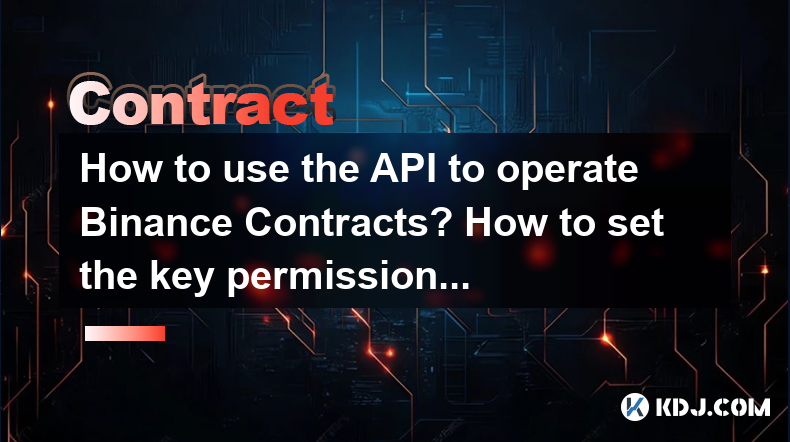-
 bitcoin
bitcoin $87959.907984 USD
1.34% -
 ethereum
ethereum $2920.497338 USD
3.04% -
 tether
tether $0.999775 USD
0.00% -
 xrp
xrp $2.237324 USD
8.12% -
 bnb
bnb $860.243768 USD
0.90% -
 solana
solana $138.089498 USD
5.43% -
 usd-coin
usd-coin $0.999807 USD
0.01% -
 tron
tron $0.272801 USD
-1.53% -
 dogecoin
dogecoin $0.150904 USD
2.96% -
 cardano
cardano $0.421635 USD
1.97% -
 hyperliquid
hyperliquid $32.152445 USD
2.23% -
 bitcoin-cash
bitcoin-cash $533.301069 USD
-1.94% -
 chainlink
chainlink $12.953417 USD
2.68% -
 unus-sed-leo
unus-sed-leo $9.535951 USD
0.73% -
 zcash
zcash $521.483386 USD
-2.87%
How to use the API to operate Binance Contracts? How to set the key permissions?
Use Binance Contracts API to automate trading: set up keys, configure permissions, place orders, manage positions, and retrieve market data for informed decisions.
May 02, 2025 at 04:35 am

Introduction to Binance Contracts API
Binance Contracts, also known as Binance Futures, provide traders with the ability to engage in leveraged trading on various cryptocurrency pairs. To automate trading strategies or integrate with other systems, users can leverage the Binance Contracts API. This API allows for a wide range of operations, from placing orders to managing positions and retrieving market data. In this article, we will explore how to use the API to operate Binance Contracts and how to set the key permissions effectively.
Setting Up Your API Keys
Before you can start using the Binance Contracts API, you need to set up your API keys. Here's how you can do it:
- Log into your Binance account and navigate to the API Management section.
- Click on Create API to generate a new API key.
- You will be prompted to enter a label for your API key, which helps you identify its purpose.
- After creating the key, you will receive an API Key and an API Secret. Keep these secure as they grant access to your account.
- You can also set IP Access Restrictions to enhance security by limiting access to specific IP addresses.
Configuring API Key Permissions
To ensure the security of your account, it's crucial to set the correct permissions for your API key. Here's how to do it:
- In the API Management section, find the API key you created and click on Edit.
- You will see a list of permissions that you can enable or disable. For Binance Contracts, you might want to enable:
- Enable Futures: This allows the API to interact with futures contracts.
- Enable Withdrawal: Be cautious with this permission as it allows funds to be withdrawn from your account.
- Enable Spot & Margin Trading: If you also want to trade spot or margin markets.
- After setting the permissions, click Save to apply the changes.
Using the API to Place Orders
Once your API keys are set up and permissions are configured, you can start using the API to place orders. Here's a step-by-step guide on how to place a market order using the Binance Contracts API:
- Initialize the API Client: Use the API Key and Secret to initialize the client. For example, in Python, you might use the
binancelibrary:from binance.client import Clientclient = Client(api_key='your_api_key', api_secret='your_api_secret') - Check Account Balance: Before placing an order, it's a good practice to check your account balance:
balance = client.futures_account_balance()print(balance) - Place a Market Order: To place a market order, you can use the
futures_create_ordermethod:order = client.futures_create_order(symbol='BTCUSDT', side='BUY', type='MARKET', quantity=0.001)print(order)
- Retrieve Order Information: After placing the order, you can retrieve its status:
order_info = client.futures_get_order(symbol='BTCUSDT', orderId=order['orderId'])print(order_info)
Managing Positions with the API
Managing positions is a critical aspect of trading futures contracts. Here's how you can use the API to manage your positions:
- Get Current Positions: To view your current positions, use the
futures_position_informationmethod:positions = client.futures_position_information()for position in positions:print(position) - Adjust Leverage: You can adjust the leverage for a specific symbol:
client.futures_change_leverage(symbol='BTCUSDT', leverage=10) - Close a Position: To close a position, you can place an order in the opposite direction:
close_order = client.futures_create_order( symbol='BTCUSDT', side='SELL', type='MARKET', quantity=0.001)print(close_order)
Retrieving Market Data
Accessing real-time market data is essential for making informed trading decisions. Here's how you can retrieve market data using the Binance Contracts API:
- Get Kline/Candlestick Data: To get historical price data, use the
futures_klinesmethod:klines = client.futures_klines(symbol='BTCUSDT', interval='1h')for kline in klines:print(kline) - Get Order Book Data: To view the current order book, use the
futures_order_bookmethod:order_book = client.futures_order_book(symbol='BTCUSDT')print(order_book)
- Get Recent Trades: To see recent trades, use the
futures_recent_tradesmethod:recent_trades = client.futures_recent_trades(symbol='BTCUSDT')for trade in recent_trades:print(trade)
Frequently Asked Questions
Q: Can I use the same API key for both spot and futures trading on Binance?A: Yes, you can use the same API key for both spot and futures trading, but you need to ensure that the key has the appropriate permissions enabled. You can enable both Enable Futures and Enable Spot & Margin Trading permissions in the API Management section.
Q: How often can I call the Binance Contracts API?A: The rate limits for the Binance Contracts API vary depending on the endpoint. For example, the futures_create_order endpoint has a rate limit of 50 requests per second. You can find detailed rate limit information in the Binance API documentation.
A: Storing API keys directly in your trading scripts is not recommended due to security risks. Instead, consider using environment variables or a secure key management system to store your API keys. This helps protect your keys from being exposed if your scripts are shared or compromised.
Q: Can I use the Binance Contracts API to automate my trading strategies?A: Yes, the Binance Contracts API is designed to support automated trading strategies. You can use it to place orders, manage positions, and retrieve market data in real-time, which are essential components of automated trading systems.
Disclaimer:info@kdj.com
The information provided is not trading advice. kdj.com does not assume any responsibility for any investments made based on the information provided in this article. Cryptocurrencies are highly volatile and it is highly recommended that you invest with caution after thorough research!
If you believe that the content used on this website infringes your copyright, please contact us immediately (info@kdj.com) and we will delete it promptly.
- NYC Subway Ditches MetroCard: A New Era for NYC Subway Fare Cards with OMNY
- 2025-12-24 06:45:01
- CRV Token Eyes Bullish Breakout: Falling Wedge Pattern Signals Potential Rally
- 2025-12-24 07:10:01
- Senator Grassley Champions Suffragettes with Commemorative Coin Amidst Design Revisions
- 2025-12-24 07:10:01
- XRP's Crossroads: Navigating Q1 2026 Forecasts Amidst Market Fear and $1,000 Speculation
- 2025-12-24 07:05:01
- Gnosis Chain's Bold Hard Fork Recovers Balancer Exploit Funds, Igniting DeFi's Immutability Debate
- 2025-12-24 07:05:01
- Ozak AI, ROI, and Token Price: Navigating the AI Crypto Wave with Stellar Returns
- 2025-12-24 06:35:01
Related knowledge

What is the difference between buying an option and writing (selling) an option?
Dec 23,2025 at 04:20pm
Definition and Core Mechanics1. Buying an option grants the purchaser the right, but not the obligation, to buy or sell a specified amount of cryptocu...

Can you trade crypto futures in the United States?
Dec 24,2025 at 03:20am
Regulatory Framework for Crypto Futures Trading1. The Commodity Futures Trading Commission (CFTC) classifies Bitcoin and Ethereum as commodities, gran...

What are the key differences between trading on a 1-hour chart vs. a 1-day chart?
Dec 24,2025 at 05:20am
Timeframe Sensitivity to Market Noise1. The 1-hour chart captures intraday volatility with far greater frequency, registering every minor liquidity sh...

What are the common chart patterns to look for in futures trading?
Dec 23,2025 at 04:59pm
Head and Shoulders Pattern1. This formation consists of three peaks: a higher middle peak (the head) flanked by two lower, roughly equal peaks (the sh...

Why was my stop-loss triggered by the mark price but not the last price?
Dec 23,2025 at 05:39pm
Understanding Mark Price Mechanics1. The mark price is a calculated value derived from a composite of index prices and funding rate adjustments, desig...

What are the tax reporting requirements for crypto futures gains and losses?
Dec 23,2025 at 06:40pm
Tax Classification of Crypto Futures Transactions1. Cryptocurrency futures contracts are treated as Section 1256 contracts under U.S. federal tax law,...

What is the difference between buying an option and writing (selling) an option?
Dec 23,2025 at 04:20pm
Definition and Core Mechanics1. Buying an option grants the purchaser the right, but not the obligation, to buy or sell a specified amount of cryptocu...

Can you trade crypto futures in the United States?
Dec 24,2025 at 03:20am
Regulatory Framework for Crypto Futures Trading1. The Commodity Futures Trading Commission (CFTC) classifies Bitcoin and Ethereum as commodities, gran...

What are the key differences between trading on a 1-hour chart vs. a 1-day chart?
Dec 24,2025 at 05:20am
Timeframe Sensitivity to Market Noise1. The 1-hour chart captures intraday volatility with far greater frequency, registering every minor liquidity sh...

What are the common chart patterns to look for in futures trading?
Dec 23,2025 at 04:59pm
Head and Shoulders Pattern1. This formation consists of three peaks: a higher middle peak (the head) flanked by two lower, roughly equal peaks (the sh...

Why was my stop-loss triggered by the mark price but not the last price?
Dec 23,2025 at 05:39pm
Understanding Mark Price Mechanics1. The mark price is a calculated value derived from a composite of index prices and funding rate adjustments, desig...

What are the tax reporting requirements for crypto futures gains and losses?
Dec 23,2025 at 06:40pm
Tax Classification of Crypto Futures Transactions1. Cryptocurrency futures contracts are treated as Section 1256 contracts under U.S. federal tax law,...
See all articles










































































